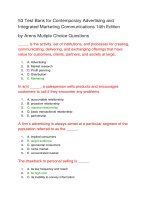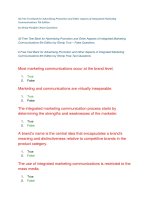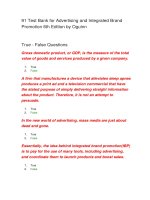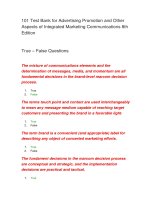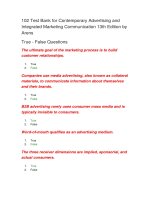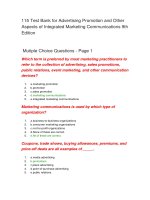Solution manual for contemporary advertising and integrated marketing communications 14th edition by arens weigold
Bạn đang xem bản rút gọn của tài liệu. Xem và tải ngay bản đầy đủ của tài liệu tại đây (533.93 KB, 15 trang )
Solution Manual for Contemporary Advertising and Integrated Marketing
Communications 14th edition by William Arens, Michael Weigold, Christian Arens
Link full download solution manual: />Link full download test bank: />CHAPTER TWO THE BIG PICTURE:
THE EVOLUTION OF IMC
At a macro level, advertising and IMC play a large role in the economic vitality of a nation. Both
consumers and sellers gain from the information about brands contained in IMC messages. To see
how, this chapter introduces the basic principles of free-market economics; the functions and effects
of advertising in a free economy; the evolution of advertising as an economic tool; and advertising’s
overall impact on society. The chapter will help you understand why the practice of advertising has
changed and how it may change even more in the future.
Learning Objectives
After studying this chapter, your students will be able to:
LO2-1 Explain the role of competition in free-market economics. LO2-2
Discuss the functions advertising performs in a free market.
LO2-3 Understand the importance of branding, including the benefits that strong brands offer
companies
LO2-4 Identify important milestones in the history of advertising.
LO2-5 Discuss how the role of advertising has changed in recent years.
LO2-6 Explore the impact of advertising on society yesterday, today and tomorrow.
Teaching Tips and Strategies
Using the Chapter Opening Vignette in the Classroom
I like to emphasize the youth of advertising as a profession, and ask students why that is so. The
earliest ads for Coca Cola date back to the nineteenth century, which is likely to seem very ancient to
students. Yet even the oldest Coke ads are just a bit over a century old. The professions of medicine,
law, and finance date back thousands of years. Prompting students in this fashion will likely lead them
to consider the importance of several nineteenth and twentieth century developments for the creation
of the modern ad industry. These include industrialization, literacy, urbanization, increases in the
standard of living and wealth (especially in the U.S. and Europe), and the development of new mass
media such as radio, television, and the Internet. Shaping the discussion in this way will lead students
to a deeper appreciation of the role that advertising plays in modern life.
2-1
© 2013 by McGraw-Hill Education. This is proprietary material solely for authorized instructor use. Not authorized for sale or
distribution in any manner. This document may not be copied, scanned, duplicated, forwarded, distributed, or posted on a webs ite,
in whole or part.
Today’s students, believe it or not, were not even born when ―New Coke‖ was introduced. I always give
a brief account of the New Coke fiasco as a way of differentiating the product (which consumers
preferred in blind taste tests) from the brand (which consumers rejected hands down to the classic
formula). For background on the discussion, see this site: I
find it also can be quite humbling to know that
the one of today’s most effective and powerful marketers can still make a terrible mistake. If nothing
else, the New Coke story helps students understand the difference between product attributes (such as
blind taste or containers) and a brand.
Other Tips and Strategies
This chapter will explain to students the evolution of advertising. It is important for students to
understand that although advertising started in the 1700s, it did not really become an everyday
occurrence until the 1800s in America. Many people that I have discussed this with believe it is
because Americans were as not focused on consumption then as they are now.
A great way to start the class is to go to Advertising Age’s timeline website
(www.adage.com/century/timeline/index.html). This site has an excellent pictorial timeline of how
advertising started in America. I recommend going over the timeline with students.
Students seem to really get interested in this information. The timeline begins with the first ad was
created in America and brings the students up to date on modern ads. There is also a timeline in the
student text.
I like to delve into the last century of advertising with students. As you know, in the 1900s ads were
very wordy. Back then, people read a lot more than they do today. This is because radios and
television sets had not yet become standard possessions. Newspapers and
magazines were consumers’ ways of catching up on the latest news. Advertisers used to make ads look
like newspaper articles to help sell products or services.
One neat fact to share with students is that Coca-Cola helped to standardize the American Santa Claus
in the 1930s through advertising. Before the standardization, I have been told that Santa was usually
called St. Nicholas, and was plump in certain countries and skinny in others. Coke was trying to
increase the market share of its product. They helped create the Santa we have today (think Christmas
Coke). The red and white colors were used to mirror the red and white Coke logo. That is the power
of a well-known brand. One website to show students is which explains the story of Santa in more detail.
2-2
© 2013 by McGraw-Hill Education. This is proprietary material solely for authorized instructor use. Not authorized for sale or
distribution in any manner. This document may not be copied, scanned, duplicated, forwarded, distributed, or posted on a webs ite,
in whole or part.
I share with students how radio and television changed advertising forever. With the advent of radio
came the live radio commercial. Now, instead of just reading about a product or service, people could
hear celebrity spokespeople on the radio. Radio ads continue to this day.
I recommend going over the advent of television and how consumers could, for the first time, actually
hear and see a product or service on television. This really helped to change advertising, and the
resulting television commercials have helped to sell billions of dollars of products through the years.
Television advertising has had its ups and downs in the last couple of decades.
Reviewing older ads with students is also both informative and entertaining. As you know, in the
1900s ads were very wordy. Back then, people read a lot more than they do today. This is because
radios and television sets had not yet become standard possessions. Newspapers and magazines were
consumers’ ways of catching up on the latest news. Advertisers used to make ads look like newspaper
articles to help sell products or services.
You can find online copies of the ads and a great deal of background information about the spots at
this great Web site: There is a wealth of
information about how such great spots as the famous ―Hillside singers‖ ad were developed.
Remind students that the advent of television allowed many consumers, for the first time, to actually
hear and see a product or service. This really helped to change advertising, and the resulting television
commercials have helped to sell billions of dollars of products through the years. I also try to
encourage students to see the challenge faced by people working in agencies as they struggled to
discover effective ways to write and produce for new media.
This point can be amplified by showing early commercials from the 1950s and contrasting them with
more current examples (I contrast old Coca Cola ads with their newer versions). Resources:
personal conversations with Dr. Tom Powers
****DID NOT EDIT THE ABOVE SECTION BECAUSE IT IS NOT IN THE
TEXT****
Web Resources for Enhancing your Lectures:
Advertising Age Historical
Timeline
Coke Ads
Ads of the World
AdRants: A blog about
advertising
www.adage.com/century/timeline/index.html
/>
2-3
© 2013 by McGraw-Hill Education. This is proprietary material solely for authorized instructor use. Not authorized for sale or
distribution in any manner. This document may not be copied, scanned, duplicated, forwarded, distributed, or posted on a webs ite,
in whole or part.
AdGabber: A social network for
people interested in advertising
Bill Bernbach
Ad*Access: John W. Hartman
Collection
AdFlip: Historical print ad archive
Ad Age: Advertising Century
/> /> /> /> />
LECTURE OUTLINE
Portfolio Review: The Modern History of Advertising
Ethical Issue: Ethical dilemma or ethical lapse?
My IMC Campaign 2: Tools for Teamwork
AD LAB 2–A
What Kills Bugs Dead?
People behind the Ads: William Bernbach
Ad Forum Exercise: ―History in a Bottle – in Coke Ads Through the Decades‖
I.
Vignette: The Coca-Cola Story
The Coca-Cola Company has approached advertising in many different ways since its beginning in
the late nineteenth century. Both Coke’s image and recipe have changed with the times, nearly breaking
the company in the 1980s, and yet it remains the world’s favorite carbonated beverage today.
II. Economics: The Functions of Advertising and IMC in Free Markets
A. Principles of Free-Market Economics
A market economy is characterized by four assumptions:
1. Self-interest—People and firms pursue their own goals. Open competition between
self-interested buyers naturally leads to greater product availability at more
competitive prices.
2. Complete information—Buyers make better decisions when they have more
information about the products they can choose from.
3. Many buyers and sellers—Having many sellers ensures that if one does not meet
customer needs, another will capitalize on the situation by producing a more
market responsive product.
2-4
© 2013 by McGraw-Hill Education. This is proprietary material solely for authorized instructor use. Not authorized for sale or
distribution in any manner. This document may not be copied, scanned, duplicated, forwarded, distributed, or posted on a webs ite,
in whole or part.
4. Absence of externalities (social costs)—Sometimes the sale or consumption
products may benefit or harm other people who are not involved in the transaction
and didn’t pay for the product. But it may also contribute significantly to health
problems and climate change through increases in air pollution and carbon
emissions. In these cases, government may use taxation and/or regulation to
compensate for or eliminate the externalities.
B. Functions and Effects of Advertising in a Free Economy
1. For a chronology of the evolution of the Coca-Cola brand and company, see
Exhibit 2–1.
2. Identify products and differentiate them from others-a function of branding
3. Communicate information about the product, its features, and its location of sale
4. Induce customers to try new products and to suggest reuse
5. Stimulate the distribution of a product
6. Increase product use
7. Build value, brand preference, and loyalty
8. To lower the overall cost of sales
C. The Brand
1. Scott M. Davis and Michael Dunn define the concept ―brand‖ as follows: Promises
made to customers…based on multiple experiences over time…delivered with a
consistently high level of quality and value…that are perceived to be unparalleled relative
to the competition,…ultimately resulting in deep, trust-based relationships…, which in
turn, garners great amounts of loyalty and profits over time.
2. Among the more specific benefits provided to a company by strong brands are these:
a. They allow for premium pricing versus competitors.
b. They afford protection against price wars.
c. They allow for a greater chance a new product will succeed.
d. They afford leverage in negotiating with channel partners.
e. They make companies more attractive to co-branding partners.
f. They help companies more effectively deal with a brand crisis.
g. They help companies recruit top talent.
h. They garner consumer loyalty.
3. To see an overview of important milestones in advertising history, see Exhibit 2–
D. The Evolution of Advertising as an Economic Tool
1. Early Advertising
2-5
© 2013 by McGraw-Hill Education. This is proprietary material solely for authorized instructor use. Not authorized for sale or
distribution in any manner. This document may not be copied, scanned, duplicated, forwarded, distributed, or posted on a webs ite,
in whole or part.
a. During the preindustrial age, several important events contributed to the
eventual development of modern advertising.
b. The Chinese invented paper around 150 B.C. Europe had its first paper mill by
1275.
c. Around 1449, Johannes Gutenberg invented the printing press in Germany. The
printing press is the most important development in the history of advertising
because it changed the way people communicated, lived, and worked.
d. In 1472, the first ad in English appeared: a handbill tacked on church doors in
London announcing a prayer book for sale.
e. 1700s: The world’s population stood at about 600 million people, and some
cities were big enough to support larger volumes of advertising.
f. Samuel Johnson, a famous English literary figure, observed in 1758 that advertisements
were now so numerous that they were ―negligently perused‖ and it had become necessary
to gain attention ―by magnificence of promise.‖ This was the beginning of puffery in
advertising.
g. In the colonies, the Boston Newsletter started carrying ads in 1704.
h. About 25 years later, Benjamin Franklin, the father of advertising art, made ads
more readable by using large headlines and considerable white space. In fact,
Franklin was the first American to use illustrations in ads.
2. The Industrial Age and the Birth of Ad Agencies
a. The industrial age began around the middle of the nineteenth century and lasted
well into the twentieth.
b. Fresh mass markets then developed for the new, inexpensive brands of consumer
luxury and convenience goods called consumer packaged goods .
c. Ads appeared in publications called price currents that informed retailers about the
sources of supply and shipping schedules for commodities.
d. The American profession of advertising began when Volney B. Palmer set
up business in Philadelphia in 1841.
e. The manufacturers changed their focus from a production orientation to a
marketing orientation.
f. In the 1920s, the era of salesmanship had arrived and its bible was Scientific
Advertising ,written by the legendary copywriter Claude Hopkins at Albert
Lasker’s agency, Lord & Thomas. Radio was born at about the same time and
rapidly became a powerful new advertising medium.
g. Manufacturers followed this strategy of product differentiation vigorously, seeking to
portray their brands as different from and better than the competition by offering
consumers quality, variety, and convenience.
3. The Golden Age
2-6
© 2013 by McGraw-Hill Education. This is proprietary material solely for authorized instructor use. Not authorized for sale or
distribution in any manner. This document may not be copied, scanned, duplicated, forwarded, distributed, or posted on a webs ite,
in whole or part.
a. The postwar period from 1946 through the 1970s is sometimes referred to as
advertising’s ―Golden Age.‖ This is because the introduction of television helped make
the advertising industry a focus of great attention, which led to both acclaim and
criticism.
b. In the prosperous late 1940s and early 1950s, seemed to many to create a culture in
which consumers tried to climb the social ladder by buying more and more
modern products.
c. USP (unique selling proposition) —features that differentiate it from competitive
products.
d. Companies turned to a new mantra: market segmentation, a process by which
marketers searched for unique groups of people whose needs could be addressed
through more specialized products.
e. The image era of the 1960s was thus the natural culmination of the creative
revolution. Advertising’s emphasis shifted from product features to brand image or
personality as advertisers sought to align their brands with particularly profitable
market segments.
f. Positioning strategy proved to be an effective way to separate a particular brand from
its competitors by associating that brand with a particular set of customer needs that
ranked high on the consumer’s priority list.
4. The Postindustrial Age
a. Beginning around 1980, the postindustrial age has been a period of
cataclysmic change.
b. Acute energy shortages of the 1970s and 1980s introduced a new
marketing term, demarketing.
c. To expand globally, big multinational companies and their advertising agencies went on a
binge, buying other big companies and creating a new word in the financial
lexicon: megamerger.
d. Two related economic factors characterized the marketing world of this period:
III.
(1) the aging of traditional products, with a corresponding growth in competition, and
(2) the growing affluence and sophistication of the consuming public, led by the huge baby
boomer generation.
D. The Global Interactive Age: Looking at the 21st Century
1. As Exhibit 2–4 shows, the top 10 worldwide advertisers are based in many
different countries.
2. In an effort to do a better job of relationship marketing, companies understand that must
be consistent in both what they say and what they do.
3. Companies must integrate all their marketing communications with everything else do, too.
That’s what integrated marketing communications really means.
Society and Ethics: The Effects of Advertising
2-7
© 2013 by McGraw-Hill Education. This is proprietary material solely for authorized instructor use. Not authorized for sale or
distribution in any manner. This document may not be copied, scanned, duplicated, forwarded, distributed, or posted on a webs ite,
in whole or part.
A. Advertising has been a major factor in improving the standard of living in the
United States and around the world..
B. Newspapers, magazines, radio, television, and many Web sites all receive their primary income
from advertising. This facilitates freedom of the press and promotes more complete
information.
C. The Red Cross, United Way, and other noncommercial organizations receive continuous financial
support and volunteer assistance due in large part to the power of advertising.
D. Advertising practitioners formed groups to improve advertising effectiveness and promote
professionalism and started vigilance committees to safeguard the integrity of the industry.
E. Advertising has had a pronounced effect on society as well as the economy. It has also fostered
a host of social attitudes and laws that have dramatically affected advertising itself.
IV.
Chapter Summary
A. Economic theory includes four fundamental assumptions of free-market economics: self- interest,
complete information, many buyers and sellers, and absence of externalities.
B. The greatest impact on the evolution of advertising has been economic.
C. With changing economies and increased competition, advertising has evolved from the
preindustrial age through the industrializing and industrial ages to the postindustrial age.
D. As a social force, advertising has helped improve the standard of living in the United States
and around the world.
E. Advertising has also been severely criticized over the years for its lack of honesty and
ethics.
Review Questions
1. What are the four fundamental assumptions of free market economics?
(1) Self-interest; (2) complete information; (3) many sellers, many buyers; (4) absence of
externalities (social costs)
2. What are the primary functions of advertising in a free economy? (Exhibit 2–2)
The primary functions of advertising in a free economy are: (1) to identify products and their
sources and to differentiate them from others; (2) to communicate information about the product,
its features, and its location of sale; (3) to induce customers to try new products and to suggest
reuse, (4) to stimulate the distribution of a product; (5) to increase product use; (6) to build value,
brand preference, and loyalty; and (7) to lower the overall cost of sales.
3. What has had the greatest impact on the way advertising has evolved?
2-8
© 2013 by McGraw-Hill Education. This is proprietary material solely for authorized instructor use. Not authorized for sale or
distribution in any manner. This document may not be copied, scanned, duplicated, forwarded, distributed, or posted on a webs ite,
in whole or part.
4.
5.
6.
7.
8.
9.
The printing press, invented by Johannes Gutenberg in the 1440s, was the most important
invention of the Preindustrial Age. The printing press revolutionized not only the system of
communication, but also the way people lived and worked. In the Industrializing Age, the advent
of industry was the most important invention, as it facilitated the mass production of products.
This trend continued in the Industrial Age, which also saw the invention of broadcast media and
greater sophistication in marketing techniques, including market segmentation. The most
important things that happened in the Postindustrial Age is the realization of the limits of natural
resources and the emergence of demarketing. The Internet is the greatest innovation of the Global
Interactive Age.
How does advertising lower the cost of sales?
Advertising can lower the cost of sales by increasing the volume of sales, which in turn lowers
the costs of manufacturing and distribution.
How would you differentiate the advertising used in the industrializing age from the
industrial age?
During the industrializing age, manufacturers were more concerned about getting products out to
the general public. Wholesalers used to advertise to the public to let them know they had a product
or service. In the industrial age, society started changing to more of a consumer-centered process.
The increased availability of competing brands led to a greater focus on differentiation, letting
consumers know how and why a product was different from its competitors.
What has been the most important influence on advertising in the postindustrial age? The
fact that consumers started realizing that our resources were not infinite.
What are three examples of companies or organizations that use a demarketing strategy? Three
examples of companies/organizations that use the demarketing strategy are states trying to
curtail smoking, utilities trying to get consumers to use less energy, and cities trying to get
consumers to limit the waste they bring to the curb each week for pickup.
What companies can you think of that are engaged in marketing warfare?
A classic example is Coke and Pepsi. They have been at each other’s throats and as of this writing,
it seems Pepsi is starting to edge ahead, especially with the purchase of Quaker Oats (which owns
Gatorade). Today the biggest competitive advertising campaigns are those of the wireless phone
companies.
As a consumer, are you likely to save money buying at a store that does not advertise?
Explain.
This answer will vary. Sometimes a decision not to advertise is an indication of exclusivity. In
such cases, shoppers will not likely save money but may still get value in the form of excellent
service (think Nordstrom’s). But in other cases, a store that does not advertise might still save
consumer money (think Dollar Stores). Often stores that advertise the prices of the items they sell
are generally trying to call attention to low prices. Consumers will likely save money shopping at
such outlets.
2-9
© 2013 by McGraw-Hill Education. This is proprietary material solely for authorized instructor use. Not authorized for sale or
distribution in any manner. This document may not be copied, scanned, duplicated, forwarded, distributed, or posted on a webs ite,
in whole or part.
10. What effects do you believe advertising has had on society in general? Explain. Advertising
can help create trends and desires. For example: BMW introduced the Z3 convertible in a
James Bond movie, which helped make that car a desired status symbol for many wealthy
middle-aged men.
Portfolio Review: The Modern History of Advertising
1.
2.
If we look back at the ad campaigns of 30, 50, 70, and even 100 years ago, we get a
fascinating indication of how life was lived back then, and we can also see how the
development of modern advertising parallels the development of our own standard of living.
Study the array of historical ads in this Portfolio Review and consider how well each relates
to the seven functions and effects of advertising discussed in this chapter.
2-10
© 2013 by McGraw-Hill Education. This is proprietary material solely for authorized instructor use. Not authorized for sale or
distribution in any manner. This document may not be copied, scanned, duplicated, forwarded, distributed, or posted on a webs ite,
in whole or part.
ETHICAL ISSUE
Ethical Dilemma or Ethical Lapse?
This is an interesting discussion to have with the class. Is it an ethical dilemma (which tends to look at how the
law would interpret it) or is it an ethical lapse (not telling the truth or trying to deceive). It is also interesting to
discuss with students WorldCom, Enron, Tyco, etc. These are all instances of unethical corporate behavior.
I try to convey to the class that the goal of advertising is to position and sell products/services. Some people
might interpret that as unethical, whereas others might interpret it as ethical. One of the dilemmas with
ethics is that what I think is ethical, you might find unethical. Sometimes ethics are open to interpretation.
My IMC Campaign 2: Tools for Teamwork
1.
Advertising agencies look for at least three qualities in the people they hire: talent,
knowledge, and the ability to work well with others.
2. First, you will need to coordinate everything that you do.
3. Second, you will be sharing work.
4. Finally, everyone is accountable. Talk to your professor about whether he or she expects
peer
evaluations or some other means to assess differences in group member effort and
performance.
Staying Connected
E-mail, of course, remains an essential tool. You may have a university e-mail account, but these can be
problematic because (1) your inbox space is limited, (2) spam filters in
these accounts are
often very aggressive (too much useful mail is moved to the spam folder), and (3) they lack many useful
tools for organizing and labeling your mail.
Creating Documents
Google docs () is a free suite of simple yet powerful document creation tools that
includes a word processor, a spreadsheet program, and a presentation creator.
Staying Organized
Many people find that calendars and to-do lists are essential. Google has an excellent calendar program
(www.google.com/calendar) that everyone in the team can edit.
Conducting Research
For secondary research purposes it is great to have a program that allows you to copy and store documents,
Web pages, photos, charts, and other kinds of information.
Working Well and Staying Accountable
Learning to adapt to group projects is not easy for everyone. Knowing what to expect and developing the skills to
work well with others is essential. For guidance, consider these thoughts from experts: Brian Tracy:
www.myarticlearchive.com/articles/6/079.htm
Susan Heathfield: Stanford
University on effective teams: www.stanford.edu/class/el40/el40a/effective.html
If you volunteer to be a team leader (or are appointed one), some helpful tips can be found here:
www.cooper.com/journal/2008/11/habits of effectiveteams.html
Stephen Covey: www.stephencovey.com/blog/?p=6
2-11
© 2013 by McGraw-Hill Education. This is proprietary material solely for authorized instructor use. Not authorized for sale or
distribution in any manner. This document may not be copied, scanned, duplicated, forwarded, distributed, or posted on a webs ite,
in whole or part.
Jack Welch, former CEO of GE (this is an hour-long video filmed at the MIT School of Management)
/>If you are doing peer evaluations in your class, your professor will likely have a form that you should use.
These types of forms can be found throughout the Web. Some examples include these:
/>www.utexas.edu/courses/kincaid/peerevaltips.html
AD LAB 2–A
What Kills Bugs Dead?
Laboratory Applications
1. Now that you know a little about slogans, create one for yourself personally or for your (real or
imagined) company. Which qualities and characteristics do you want your slogan to highlight?
Share your slogan with your classmates and gauge their reactions.
Answers to this question will vary. The key is to make sure the student’s slogans sound
compelling. This exercise will also help students realize that these slogans are not as easy to
create as they might have thought.
2. Business cards serve a higher purpose than simply providing information for a Rolodex. They
are mini-advertisements. Create a business card for yourself using your slogan.
This is a fun exercise to have students turn in. It always amazes me what students come up with.
Internet Exercise
1. Need help getting started on your slogan assignment? Adslogans.com has step-by-step instructions
that lead you through the process (www.adslogans.co.uk/general/students.html). For more ideas,
look at slogans and ad campaigns past and present at www.adflip.com.
People behind the Ads: William Bernbach
1.
For most of the 1950s creativity carried little currency.
2.
But by 1959 a creative revolution was brewing, led by the founder and creative leader of an
upstart New York agency, Doyle Dane Bernbach.
Contradicting Hopkins’s claim that advertising was a science, Bernbach wrote: ―I don’t want
academicians. I don’t want scientists. I don’t want people who do the right things. I want people
who do inspiring things…Let us blaze new trails.‖
Bernbach developed copy that encouraged consumers to reject groupthink, the mass
society, and the idea that everyone should be like everyone else.
Bernbach passed away in 1982 after a fabled career, but his legacy is intact. Harper’s
Magazine, noting his passing, wrote that Bernbach had made ―a greater impact on American
culture than any of the distinguished writers and artists‖ appearing in the magazine during
its 133 years.
3.
4.
5.
Ad Forum Exercise: “History in a Bottle – in Coke Ads Through the Decades”
2-12
© 2013 by McGraw-Hill Education. This is proprietary material solely for authorized instructor use. Not authorized for sale or
distribution in any manner. This document may not be copied, scanned, duplicated, forwarded, distributed, or posted on a webs ite,
in whole or part.
The Chapter 2 Playlist brings together American and International ads for beverage giant Coca Cola.
One purpose of the playlist is to see some older Coke ads and to compare them with newer spots. A
second purpose is to compare ads for Coke that air in the United States and compare these with spots
from around the world.
1. Compare the following ads: Hilltop Reunion (1960s), Mean Joe Greene (1970s), Polar Bears–
Christmas (1990s), Grand Theft Coke (2000s).
a. Has Coke’s basic promise to consumers changed over the years? If so, how?
b. What is that promise?
c. How important is cultural knowledge and understanding for the effectiveness of the ads? Do you
know who Mean Joe Greene was? Did you know the Hilltop ad became so popular that the song
was recorded for a nonadvertising use and became a staple on popular radio?
2.
Compare the following ads: Burp (Denmark), Big Splash (Argentina), Illumina La
Città Di Milano
(Italy), 2008 Olympics (China case study), Arctic Beach Party
(USA), Signs
(USA), Black History (USA).
a. What changes about the way Coke is advertised when the message originates
internationally rather than in the United States Which international ads, if run in the United
States, would still be effective at convincing consumers to prefer Coke?
Which U.S. ads would be effective in international markets? What distinguishes ads
that you
believe effectively transcend their country from those you think would be
less
successful?
To access the chapter playlists go to www.mhhe.com/arens14e.
The Advertising Experience
1.
Ad Action: Demarketing
Identify a social problem at your school that has had an effect on your life in the past few months.
Then create a print demarketing advertisement that addresses this problem. The ad should have a
visual element as well as a slogan.
2. Economic Perspectives of Advertising
Visit the Web pages listed below and find the articles on the economics of advertising. After studying
them, do you believe advertising primarily promotes monopoly or does it foster many buyers and
sellers? Support your argument with points from the articles.
a. ―The Economics of Advertising‖ (Introduction), 2001— introductory essay to a
volume edited by Columbia University economist Kyle Bagwell:
www.columbia.edu/%7Ekwb8/advertisingintrofv2.pdf
b. ―Advertising,‖ The Library of Economics and Liberty: The Concise Encyclopedia of
Econimics —an interesting primer by Prof. George Bittlingmayer , University of Kansas:
www.econlib.org/library/Enc/Advertising.html
3.
Advertising History
2-13
© 2013 by McGraw-Hill Education. This is proprietary material solely for authorized instructor use. Not authorized for sale or
distribution in any manner. This document may not be copied, scanned, duplicated, forwarded, distributed, or posted on a webs ite,
in whole or part.
Go online and visit the sites listed below to see what else you can learn out about the early
advertising efforts of companies here and abroad. Can you find some early ads for Kodak? Coca- Cola?
Sunkist? Who are some of the other major advertisers listed? What specific characteristics in art and copy
styles do you notice that make these ads different from advertising today?
a.
b.
c.
d.
e.
f.
g.
4.
The Emergence of Advertising in America section of the John W. Hartman Center for
Sales, Advertising, & Marketing History at Duke University:
/>Archives of the History of Advertising Trust: www.hatads.org/uk/home.html
William F. Eisner Museum of Advertising and Design (Milwaukee, WI):
www.eisnermuseum.org
The Museum of Broadcast Communications (Chicago, IL): www.museum.tv/index.html
Nineteenth-century advertising in Harper’s Weekly magazine:
USATVADS (a large - more than one million examples- pay-site collection of American
television commercials): www.usatvads.net
Advertising, marketing, and commercial imagery collections of the National Museum of
American History at the Smithsonian: />
Volkswagen’s advertising from the early 1960s was clearly quite different from that of its
competitors—perhaps because of its decision to pair copywriters with art directors, a partnership
that is now all but standard in the advertising industry. But did other automakers sit up and take
notice? Find some examples of American auto advertising in
the years since that could potentially have been influenced by DDB’s VW work.
Discussion Guidelines:
Mini’s advertising relies on the characteristics that made Volkswagen’s early print work
successful. Also, for more than twenty-five years Honda’s print ads have employed a consistent
layout; sparse design; and modest, unassuming copy to speak to their audience.
5.
Some Coca-Cola investors want the company to spend more on advertising products in growing
categories, such as sports drinks, and less on trying to revive consumer interest
full-calorie soft drinks. How would you respond to these shareholders?
in
Discussion Guidelines:
Students should consider the global domination of both the Coca-Cola brand and the Coca-Cola
soft drink; the incredible growth of the energy drink market in the last five years; the current
degree of saturation in the energy drink market and whether Coke would have the means and
brand imperative to stand out from the quickly growing crowd; whether Coke needs to tap into this
market to grow or whether doing so would dilute their brand, and whether the energy drink market
has longevity or is just a fad.
6. After stirring up consumers’ emotions and shaking their faith in the company by I ntroducing New
Coke, company executives have been treading somewhat lightly for the last 20 years. Do you think their
efforts to conserve and protect the brand have stifled the
creativity of Coca-Cola
advertising? Why or why not?
2-14
© 2013 by McGraw-Hill Education. This is proprietary material solely for authorized instructor use. Not authorized for sale or
distribution in any manner. This document may not be copied, scanned, duplicated, forwarded, distributed, or posted on a webs ite,
in whole or part.
Discussion Guidelines:
Students may consider the great success of the polar bear characters in Coke’s winter advertising;
the number of new beverages Coke has introduced in recent times (including Coke Blak); and the
variety of Pepsi ad strategies and the competitiveness with which Pepsi has pursued Coke.
2-15
© 2013 by McGraw-Hill Education. This is proprietary material solely for authorized instructor use. Not authorized for sale or
distribution in any manner. This document may not be copied, scanned, duplicated, forwarded, distributed, or posted on a webs ite,
in whole or part.

